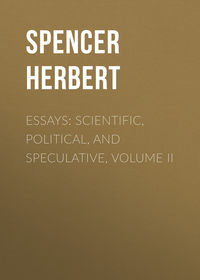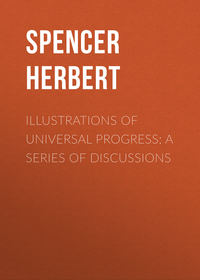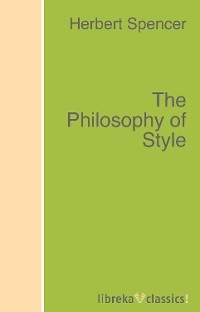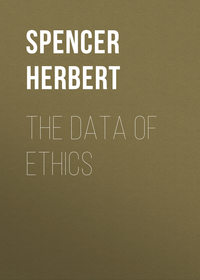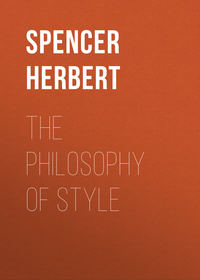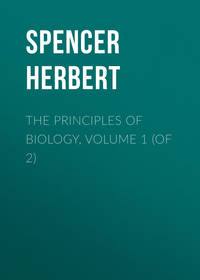 полная версия
полная версияFirst Principles
Shall we then take refuge in the Kantian doctrine? shall we say that Space and Time are forms of the intellect, – “à priori laws or conditions of the conscious mind”? To do this is to escape from great difficulties by rushing into greater. The proposition with which Kant’s philosophy sets out, verbally intelligible though it is, cannot by any effort be rendered into thought – cannot be interpreted into an idea properly so called, but stands merely for a pseud-idea. In the first place, to assert that Space and Time, as we are conscious of them, are subjective conditions, is by implication to assert that they are not objective realities: if the Space and Time present to our minds belong to the ego, then of necessity they do not belong to the non-ego. Now it is absolutely impossible to think this. The very fact on which Kant bases his hypothesis – namely that our consciousness of Space and Time cannot be suppressed – testifies as much; for that consciousness of Space and Time which we cannot rid ourselves of, is the consciousness of them as existing objectively. It is useless to reply that such an inability must inevitably result if they are subjective forms. The question here is – What does consciousness directly testify? And the direct testimony of consciousness is, that Time and Space are not within but without the mind; and so absolutely independent of it that they cannot be conceived to become non-existent even were the mind to become non-existent. Besides being positively unthinkable in what it tacitly denies, the theory of Kant is equally unthinkable in what it openly affirms. It is not simply that we cannot combine the thought of Space with the thought of our own personality, and contemplate the one as a property of the other – though our inability to do this would prove the inconceivableness of the hypothesis – but it is that the hypothesis carries in itself the proof of its own inconceivableness. For if Space and Time are forms of thought, they can never be thought of; since it is impossible for anything to be at once the form of thought and the matter of thought. That Space and Time are objects of consciousness, Kant emphatically asserts by saying that it is impossible to suppress the consciousness of them. How then, if they are objects of consciousness, can they at the same time be conditions of consciousness? If Space and Time are the conditions under which we think, then when we think of Space and Time themselves, our thoughts must be unconditioned; and if there can thus be unconditioned thoughts, what becomes of the theory?
It results therefore that Space and Time are wholly incomprehensible. The immediate knowledge which we seem to have of them, proves, when examined, to be total ignorance. While our belief in their objective reality is insurmountable, we are unable to give any rational account of it. And to posit the alternative belief (possible to state but impossible to realize) is merely to multiply irrationalities.
§ 16. Were it not for the necessities of the argument, it would be inexcusable to occupy the reader’s attention with the threadbare, and yet unended, controversy respecting the divisibility of matter. Matter is either infinitely divisible or it is not: no third possibility can be named. Which of the alternatives shall we accept? If we say that Matter is infinitely divisible, we commit ourselves to a supposition not realizable in thought. We can bisect and re-bisect a body, and continually repeating the act until we reduce its parts to a size no longer physically divisible, may then mentally continue the process without limit. To do this, however, is not really to conceive the infinite divisibility of matter, but to form a symbolic conception incapable of expansion into a real one, and not admitting of other verification. Really to conceive the infinite divisibility of matter, is mentally to follow out the divisions to infinity; and to do this would require infinite time. On the other hand, to assert that matter is not infinitely divisible, is to assert that it is reducible to parts which no conceivable power can divide; and this verbal supposition can no more be represented in thought than the other. For each of such ultimate parts, did they exist, must have an under and an upper surface, a right and a left side, like any larger fragment. Now it is impossible to imagine its sides so near that no plane of section can be conceived between them; and however great be the assumed force of cohesion, it is impossible to shut out the idea of a greater force capable of overcoming it. So that to human intelligence the one hypothesis is no more acceptable than the other; and yet the conclusion that one or other must agree with the fact, seems to human intelligence unavoidable.
Again, leaving this insoluble question, let us ask whether substance has, in reality, anything like that extended solidity which it presents to our consciousness. The portion of space occupied by a piece of metal, seems to eyes and fingers perfectly filled: we perceive a homogeneous, resisting mass, without any breach of continuity. Shall we then say that Matter is as actually solid as it appears? Shall we say that whether it consists of an infinitely divisible element or of ultimate units incapable of further division, its parts are everywhere in actual contact? To assert as much entangles us in insuperable difficulties. Were Matter thus absolutely solid, it would be, what it is not – absolutely incompressible; since compressibility, implying the nearer approach of constituent parts, is not thinkable unless there is unoccupied space between the parts. Nor is this all. It is an established mechanical truth, that if a body, moving at a given velocity, strikes an equal body at rest in such wise that the two move on together, their joint velocity will be but half that of the striking body. Now it is a law of which the negation is inconceivable, that in passing from any one degree of magnitude to any other, all intermediate degrees must be passed through. Or, in the case before us, a body moving at velocity 4, cannot, by collision, be reduced to velocity 2, without passing through all velocities between 4 and 2. But were Matter truly solid – were its units absolutely incompressible and in absolute contact – this “law of continuity,” as it is called, would be broken in every case of collision. For when, of two such units, one moving at velocity 4 strikes another at rest, the striking unit must have its velocity 4 instantaneously reduced to velocity 2; must pass from velocity 4 to velocity 2 without any lapse of time, and without passing through intermediate velocities; must be moving with velocities 4 and 2 at the same instant, which is impossible.
The supposition that Matter is absolutely solid being untenable, there presents itself the Newtonian supposition, that it consists of solid atoms not in contact but acting on each other by attractive and repulsive forces, varying with the distances. To assume this, however, merely shifts the difficulty: the problem is simply transferred from the aggregated masses of matter to these hypothetical atoms. For granting that Matter, as we perceive it, is made up of such dense extended units surrounded by atmospheres of force, the question still arises – What is the constitution of these units? We have no alternative but to regard each of them as a small piece of matter. Looked at through a mental microscope, each becomes a mass of substance such as we have just been contemplating. Exactly the same inquiries may be made respecting the parts of which each atom consists; while exactly the same difficulties stand in the way of every answer. And manifestly, even were the hypothetical atom assumed to consist of still minuter ones, the difficulty would re-appear at the next step; nor could it be got rid of even by an infinite series of such assumptions.
Boscovich’s conception yet remains to us. Seeing that Matter could not, as Leibnitz suggested, be composed of unextended monads (since the juxtaposition of an infinity of points having no extension, could not produce that extension which matter possesses); and perceiving objections to the view entertained by Newton; Boscovich proposed an intermediate theory, uniting, as he considered, the advantages of both and avoiding their difficulties. His theory is, that the constituents of Matter are centres of force – points without dimensions, which attract and repel each other in suchwise as to be kept at specific distances apart. And he argues, mathematically, that the forces possessed by such centres might so vary with the distances, that under given conditions the centres would remain in stable equilibrium with definite interspaces; and yet, under other conditions, would maintain larger or smaller interspaces. This speculation however, ingeniously as it is elaborated, and eluding though it does various difficulties, posits a proposition which cannot by any effort be represented in thought: it escapes all the inconceivabilities above indicated, by merging them in the one inconceivability with which it sets out. A centre of force absolutely without extension is unthinkable: answering to these words we can form nothing more than a symbolic conception of the illegitimate order. The idea of resistance cannot be separated in thought from the idea of an extended body which offers resistance. To suppose that central forces can reside in points not infinitesimally small but occupying no space whatever – points having position only, with nothing to mark their position – points in no respect distinguishable from the surrounding points that are not centres of force; – to suppose this, is utterly beyond human power.
Here it may possibly be said, that though all hypotheses respecting the constitution of Matter commit us to inconceivable conclusions when logically developed, yet we have reason to think that one of them corresponds with the fact. Though the conception of Matter as consisting of dense indivisible units, is symbolic and incapable of being completely thought out, it may yet be supposed to find indirect verification in the truths of chemistry. These, it is argued, necessitate the belief that Matter consists of particles of specific weights, and therefore of specific sizes. The general law of definite proportions seems impossible on any other condition than the existence of ultimate atoms; and though the combining weights of the respective elements are termed by chemists their “equivalents,” for the purpose of avoiding a questionable assumption, we are unable to think of the combination of such definite weights, without supposing it to take place between definite numbers of definite particles. And thus it would appear that the Newtonian view is at any rate preferable to that of Boscovich. A disciple of Boscovich, however, may reply that his master’s theory is involved in that of Newton; and cannot indeed be escaped. “What,” he may ask, “is it that holds together the parts of these ultimate atoms?”. “A cohesive force,” his opponent must answer. “And what,” he may continue, “is it that holds together the parts of any fragments into which, by sufficient force, an ultimate atom might be broken?” Again the answer must be – a cohesive force. “And what,” he may still ask, “if the ultimate atom were, as we can imagine it to be, reduced to parts as small in proportion to it, as it is in proportion to a tangible mass of matter – what must give each part the ability to sustain itself, and to occupy space?” Still there is no answer but – a cohesive force. Carry the process in thought as far as we may, until the extension of the parts is less than can be imagined, we still cannot escape the admission of forces by which the extension is upheld; and we can find no limit until we arrive at the conception of centres of force without any extension.
Matter then, in its ultimate nature, is as absolutely incomprehensible as Space and Time. Frame what suppositions we may, we find on tracing out their implications that they leave us nothing but a choice between opposite absurdities.
§ 17. A body impelled by the hand is clearly perceived to move, and to move in a definite direction: there seems at first sight no possibility of doubting that its motion is real, or that it is towards a given point. Yet it is easy to show that we not only may be, but usually are, quite wrong in both these judgments. Here, for instance, is a ship which, for simplicity’s sake, we will suppose to be anchored at the equator with her head to the West. When the captain walks from stem to stern, in what direction does he move? East is the obvious answer – an answer which for the moment may pass without criticism. But now the anchor is heaved, and the vessel sails to the West with a velocity equal to that at which the captain walks. In what direction does he now move when he goes from stem to stern? You cannot say East, for the vessel is carrying him as fast towards the West as he walks to the East; and you cannot say West for the converse reason. In respect to surrounding space he is stationary; though to all on board the ship he seems to be moving. But now are we quite sure of this conclusion? – Is he really stationary? When we take into account the Earth’s motion round its axis, we find that instead of being stationary he is travelling at the rate of 1000 miles per hour to the East; so that neither the perception of one who looks at him, nor the inference of one who allows for the ship’s motion, is anything like the truth. Nor indeed, on further consideration, shall we find this revised conclusion to be much better. For we have forgotten to allow for the Earth’s motion in its orbit. This being some 68,000 miles per hour, it follows that, assuming the time to be midday, he is moving, not at the rate of 1000 miles per hour to the East, but at the rate of 67,000 miles per hour to the West. Nay, not even now have we discovered the true rate and the true direction of his movement. With the Earth’s progress in its orbit, we have to join that of the whole Solar system towards the constellation Hercules; and when we do this, we perceive that he is moving neither East nor West, but in a line inclined to the plane of the Ecliptic, and at a velocity greater or less (according to the time of the year) than that above named. To which let us add, that were the dynamic arrangements of our sidereal system fully known to us, we should probably discover the direction and rate of his actual movement to differ considerably even from these. How illusive are our ideas of Motion, is thus made sufficiently manifest. That which seems moving proves to be stationary; that which seems stationary proves to be moving; while that which we conclude to be going rapidly in one direction, turns out to be going much more rapidly in the opposite direction. And so we are taught that what we are conscious of is not the real motion of any object, either in its rate or direction; but merely its motion as measured from an assigned position – either the position we ourselves occupy or some other. Yet in this very process of concluding that the motions we perceive are not the real motions, we tacitly assume that there are real motions. In revising our successive judgments concerning a body’s course or velocity, we take for granted that there is an actual course and an actual velocity – we take for granted that there are fixed points in space with respect to which all motions are absolute; and we find it impossible to rid ourselves of this idea. Nevertheless, absolute motion cannot even be imagined, much less known. Motion as taking place apart from those limitations of space which we habitually associate with it, is totally unthinkable. For motion is change of place; but in unlimited space, change of place is inconceivable, because place itself is inconceivable. Place can be conceived only by reference to other places; and in the absence of objects dispersed through space, a place could be conceived only in relation to the limits of space; whence it follows that in unlimited space, place cannot be conceived – all places must be equidistant from boundaries that do not exist. Thus while we are obliged to think that there is an absolute motion, we find absolute motion incomprehensible.
Another insuperable difficulty presents itself when we contemplate the transfer of Motion. Habit blinds us to the marvelousness of this phenomenon. Familiar with the fact from childhood, we see nothing remarkable in the ability of a moving thing to generate movement in a thing that is stationary. It is, however, impossible to understand it. In what respect does a body after impact differ from itself before impact? What is this added to it which does not sensibly affect any of its properties and yet enables it to traverse space? Here is an object at rest and here is the same object moving. In the one state it has no tendency to change its place; but in the other it is obliged at each instant to assume a new position. What is it which will for ever go on producing this effect without being exhausted? and how does it dwell in the object? The motion you say has been communicated. But how? – What has been communicated? The striking body has not transferred a thing to the body struck; and it is equally out of the question to say that it has transferred an attribute. What then has it transferred?
Once more there is the old puzzle concerning the connexion between Motion and Rest. We daily witness the gradual retardation and final stoppage of things projected from the hand or otherwise impelled; and we equally often witness the change from Rest to Motion produced by the application of force. But truly to represent these transitions in thought, we find impossible. For a breach of the law of continuity seems necessarily involved; and yet no breach of it is conceivable. A body travelling at a given velocity cannot be brought to a state of rest, or no velocity, without passing through all intermediate velocities. At first sight nothing seems easier than to imagine it doing this. It is quite possible to think of its motion as diminishing insensibly until it becomes infinitesimal; and many will think equally possible to pass in thought from infinitesimal motion to no motion. But this is an error. Mentally follow out the decreasing velocity as long as you please, and there still remains some velocity. Halve and again halve the rate of movement for ever, yet movement still exists; and the smallest movement is separated by an impassable gap from no movement. As something, however minute, is infinitely great in comparison with nothing; so is even the least conceivable motion, infinite as compared with rest. The converse perplexities attendant on the transition from Rest to Motion, need not be specified. These, equally with the foregoing, show us that though we are obliged to think of such changes as actually occurring, their occurrence cannot be realized.
Thus neither when considered in connexion with Space, nor when considered in connexion with Matter, nor when considered in connexion with Rest, do we find that Motion is truly cognizable. All efforts to understand its essential nature do but bring us to alternative impossibilities of thought.
§ 18. On lifting a chair, the force exerted we regard as equal to that antagonistic force called the weight of the chair; and we cannot think of these as equal without thinking of them as like in kind; since equality is conceivable only between things that are connatural. The axiom that action and reaction are equal and in opposite directions, commonly exemplified by this very instance of muscular effort versus weight, cannot be mentally realized on any other condition. Yet, contrariwise, it is incredible that the force as existing in the chair really resembles the force as present to our minds. It scarcely needs to point out that the weight of the chair produces in us various feelings according as we support it by a single finger, or the whole hand, or the leg; and hence to argue that as it cannot be like all these sensations there is no reason to believe it like any. It suffices to remark that since the force as known to us is an affection of consciousness, we cannot conceive the force existing in the chair under the same form without endowing the chair with consciousness. So that it is absurd to think of Force as in itself like our sensation of it, and yet necessary so to think of it if we realize it in consciousness at all.
How, again, can we understand the connexion between Force and Matter? Matter is known to us only through its manifestations of Force: our ultimate test of Matter is the ability to resist: abstract its resistance and there remains nothing but empty extension. Yet, on the other hand, resistance is equally unthinkable apart from Matter – apart from something extended. Not only, as pointed out some pages back, are centres of force devoid of extension unimaginable; but, as an inevitable corollary, we cannot imagine either extended or unextended centres of force to attract and repel other such centres at a distance, without the intermediation of some kind of matter. We have here to remark, what could not without anticipation be remarked when treating of Matter, that the hypothesis of Newton, equally with that of Boscovich, is open to the charge that it supposes one thing to act upon another through a space which is absolutely empty – a supposition which cannot be represented in thought. This charge is indeed met by the introduction of a hypothetical fluid existing between the atoms or centres. But the problem is not thus solved: it is simply shifted, and re-appears when the constitution of this fluid is inquired into. How impossible it is to elude the difficulty presented by the transfer of Force through space, is best seen in the case of astronomical forces. The Sim acts upon us in such way as to produce the sensations of light and heat; and we have ascertained that between the cause as existing in the Sun, and the effect as experienced on the Earth, a lapse of about eight minutes occurs: whence unavoidably result in us, the conceptions of both a force and a motion. So that for the assumption of a luminiferous ether, there is the defence, not only that the exercise of force through 95,000,000 of miles of absolute vacuum is inconceivable, but also that it is impossible to conceive motion in the absence of something moved. Similarly in the case of gravitation. Newton described himself as unable to think that the attraction of one body for another at a distance, could be exerted in the absence of an intervening medium. But now let us ask how much the forwarder we are if an intervening medium be assumed. This ether whose undulations according to the received hypothesis constitute heat and light, and which is the vehicle of gravitation – how is it constituted? We must regard it, in the way that physicists do regard it, as composed of atoms which attract and repel each other – infinitesimal it may be in comparison with those of ordinary matter, but still atoms. And remembering that this ether is imponderable, we are obliged to conclude that the ratio between the interspaces of these atoms and the atoms themselves, is incommensurably greater than the like ratio in ponderable matter; else the densities could not be incommensurable. Instead then of a direct action by the Sun upon the Earth without anything intervening, we have to conceive the Sun’s action propagated through a medium whose molecules are probably as small relatively to their interspaces as are the Sun and Earth compared with the space between them: we have to conceive these infinitesimal molecules acting on each other through absolutely vacant spaces which are immense in comparison with their own dimensions. How is this conception easier than the other? We still have mentally to represent a body as acting where it is not, and in the absence of anything by which its action may be transferred; and what matters it whether this takes place on a large or a small scale? We see therefore that the exercise of Force is altogether unintelligible. We cannot imagine it except through the instrumentality of something having extension; and yet when we have assumed this something, we find the perplexity is not got rid of but only postponed. We are obliged to conclude that matter, whether ponderable or imponderable, and whether aggregated or in its hypothetical units, acts upon matter through absolutely vacant space; and yet this conclusion is positively unthinkable.
Again, Light, Heat, Gravitation and all central forces, vary inversely as the squares of the distances; and physicists in their investigations assume that the units of matter act upon each other according to the same law – an assumption which indeed they are obliged to make; since this law is not simply an empirical one, but one deducible mathematically from the relations of space – one of which the negation is inconceivable. But now, in any mass of matter which is in internal equilibrium, what must follow? The attractions and repulsions of the constituent atoms are balanced. Being balanced, the atoms remain at their present distances; and the mass of matter neither expands nor contracts. But if the forces with which two adjacent atoms attract and repel each other both vary inversely as the squares of the distances, as they must; and if they are in equilibrium at their present distances, as they are; then, necessarily, they will be in equilibrium at all other distances. Let the atoms be twice as far apart, and their attractions and repulsions will both be reduced to one fourth of their present amounts. Let them be brought within half the distance, and their attractions and repulsions will both be quadrupled. Whence it follows that this matter will as readily as not assume any other density; and can offer no resistance to any external agents. Thus we are obliged to say that these antagonist molecular forces do not both vary inversely as the squares of the distances, which is unthinkable; or else that matter does not possess that attribute of resistance by which alone we distinguish it from empty space, which is absurd.


